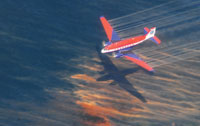As oil major BP deploys an unprecedented quantity of chemical dispersants in response to the oil spill in the Gulf of Mexico, Helen Carmichael takes a closer look at the impact
The Deepwater Horizon drilling rig explosion in the Gulf of Mexico on 20 April 2010 killed 11 people, blazed for 36 hours and finally sank the rig on 22 April. The world has been watching BP’s attempts to stem the oil flow it estimates is escaping at 5000bbl/ day from the well, located around 40 miles from the Louisiana, US, coast. The true size of the spill is not known, with some experts putting the oil leak several orders of magnitude larger than BP’s estimate.
Oil spill dispersants – chemicals applied directly to oil at the water surface – are one of the first countermeasures deployed to tackle an oil slick. Delivered by special equipment mounted on a helicopter, plane or ship, the dispersants form a plume or cloud of oil droplets just below the surface of the water.
Dilute and disperse
‘There has to be enough wave action to mix it in to form micro droplets 50–100μm in diameter in the water column,’ explains Edward Overton, an emeritus professor of environmental sciences at Louisiana State University who is currently analysing spill samples. Like common household detergents, dispersants allow the oily phase to dilute and disperse, rather than sitting on the surface. The increased surface area, combined with chemical action, paves the way for bacterial breakdown of oil compounds. ‘You’re giving the bacteria better access to food,’ says Overton. ‘If oxygen is also available, they go to town.’
US Environmental Protection Agency (EPA) administrator Lisa Jackson said: ‘This is an approach we are familiar with and a strategy we have turned to because one… dispersants biodegrade much more rapidly than oil; and two, dispersing the oil will help reduce the amount and the intensity of oil that reaches the shores and fragile wetlands, an urgent priority at this time.’
Moving into uncharted waters, the authorities allowed BP to test dispersants’ effectiveness deep below the surface, a move the EPA called ‘unprecedented’. Satisfied with preliminary results, the EPA gave BP the go-ahead for full-scale deployment of dispersants at greater depths on 15 May 2010.
The move is intended to cut the amount of dispersants used and keep the oil out at sea, rather than having it wash up on vulnerable shorelines. Another important factor, Overton suggests, is the human health considerations for those involved in the cleanup. If the oil is kept out at sea, workers will be shielded from the hydrocarbons off-gassed by the slick and any dispersant fumes. The unknown in this deeper deployment experiment is whether the resulting droplets will affect the amount of dissolved oxygen, which could dent bacterial bioremediation effectiveness.
No one knows the longer-term effects of underwater dispersant use on the environment, but early indicators from the EPA suggest that it has paid off for now. The EPA has now said overall dispersant use by BP should be reined in ‘because sub-sea use appears to be having a positive effect’. This means less is needed at the surface. ‘We believe we can reduce the amount of dispersant applied by as much as half, and possibly more,’ Jackson said.
BP was widely criticised for its choice of dispersant products, namely Corexit 9527 and Corexit 9500 produced by Nalco. Critics suggest that EPA pre-approved alternatives shown to be less toxic are available and that Corexit is also not optimal for use with Louisiana crude oil.
The ingredients in products such as Corexit are proprietary. However, the EPA says that even though it can not reveal these publicly, its scientists do have the full recipe and are taking all chemical constituents into account.
Nalco spokesman Charles Pajor told Chemistry & Industry that its Corexit products have a 20- year track record against major oil spills. ‘Our dispersants were chosen by responders to deal with the Deepwater Horizon oil spill in the Gulf of Mexico because they are approved, safe, effective, available and have a long history of successful use,’ he said.
‘Nalco was contacted after the spill and immediately sent our on hand stock of Corexit 9500 to the Gulf,’ says Pajor. The company quickly ramped up production at its plants to provide more Corexit 9500. According to Nalco, responders worldwide also raided their stockpiles and brought more of the product to the scene, along with Corexit 9527.
The older product, Corexit 9527, contains 2-butoxyethanol, a known human carcinogen also toxic to animals and other life, and propylene glycol in its proprietary mix. Paul Anastas, assistant administrator of the EPA’s Office of Research and Development, says: ‘Corexit 9527 has been around since the 80s and over time the dispersing agents have been becoming both more and more effective and also more environmentally friendly.’ The later 9500 version of the product no longer contains 2-butoxyethanol, which has been replaced with a ‘petroleum based solvent’.
Nalco declined to give more information on Corexit’s components, but Pajor said the products contained seven primary ingredients. ‘Each and every one of these ingredients is a common household product, including food and packaging materials, skin care products and bath and kitchen cleaners.’
When BP came to choose a dispersant it had to pick one from those listed on the National Contingency Plan Product Schedule – products already approved and tested for effectiveness. As well as Corexit’s pre-approval by the EPA and US Coast Guard, BP says ‘no other dispersant was available in the required amounts at the time of the oil spill’.

In its detailed response to the EPA, BP identified eight alternative dispersants to Corexit, from which Dispersit, made by Polychem, was selected. Introduced in 1999, Polychem claims its product is more effective, less toxic to marine life and completely safe for humans coming into contact with it. Significantly, the product is water-based, whereas competing products are formulated with petroleum mineral spirits – effectively adding more petroleum products to the spill.
It remains to be seen whether Dispersit makes a significant difference and, in any case, vast amounts of Corexit are already in the water. ‘Dispersant use is controversial – nobody’s happy with any of the options,’ says Overton. ‘Which is the lesser of two evils? Dispersant use offshore, or letting the oil come ashore and deal with it there? In my opinion, probably trying to disperse it offshore.’
‘In all of this, it is critical to remember that the number one enemy is the oil,’ said Jackson. ‘Until we find a way to stem the flow of oil, we must continue to take any responsible action that will mitigate the impact of the spill.’
Helen Carmichael is a freelance science writer and editor based in Vancouver, Canada.
Bacteria enlisted in oil battle
Microorganisms, fungi, green plants or their enzymes can help return the environment to its natural condition following contamination, a process known as bioremediation. Following the Exxon Valdez oil spill in 1989, Exxon added fertilisers to boost bacterial growth in the Prince William Sound in Alaska, so the bacteria could chew their way through the oil more rapidly.
Given enough oxygen, native microorganisms readily degrade many hydrocarbons, both aromatic and aliphatic. In 1995, US microbiology experts Ronald Atlas and Carl Cerniglia found that soil microbes degraded the hydrocarbons pristine and phytane from the Exxon Valdez disaster. These microbes had evolved this ability to consume terpenes, produced by the surrounding pine trees.
BP greases the wheels of research with $500m cash pledge
In the wake of the spill, BP announced a commitment of up to $500m to an open research programme studying the impact of the incident, and BP’s response, on the marine and shoreline environment of the Gulf of Mexico.
Supplementing current marine research in the Gulf of Mexico, the oil company says the new 10-year research programme will attempt to discover the fate of oil and dispersants, their effect on the environment, how the spill compares with natural oil seepage and will also attempt to develop better technology to deal with future spills.
Louisiana State University, which has been heavily involved in research during the current incident and which has significant experience dealing with the oil and gas industry, will receive one of the first grants.





